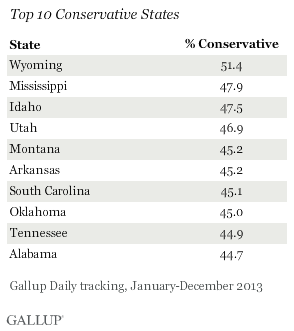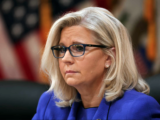The Word ‘Liberal’ is Experiencing a Resurgence in American Life –
By Glynn Wilson –
Could it be that the people of my home state are finally starting to get their news online and waking up to the ravages of run amok corporate capitalism and the do-nothing nature of conservative Republicans who don’t know how to run a government?
According to the latest Gallup poll on ideology and party identification in the United States, Dick Cheney’s Wyoming replaced Alabama as the most conservative state in the union last year. A majority, 51.4 percent, of Wyoming residents say they are ideological conservative Republicans, while only 44.7 percent of Alabama residents identify themselves that way, moving the state down to the No. 10 spot on the Top Ten Most Conservative States.
Thank dog for Mississippi, which is now the second most conservative state and the most conservative Southern state. The next three states on the list are all out west, Idaho, Utah and Montana. But Arkansas, South Carolina, Oklahoma and Tennessee are not far behind.
Predictably, Washington, D.C. still ranks as the most liberal area in the United States, with Vermont and Massachusetts having the highest percentage of liberals among the 50 states. Next are Delaware, New York, Hawaii, Oregon, Maine, California and New Jersey.
“Overall, Americans were much more likely to self-identify as conservatives than as liberals last year, though that gap shrank from previous years,” Gallup says, which may be confirmation of the progressive demographic shift pundits are talking about in the American electorate.
The most conservative states are obviously located primarily in the South and West, while the most liberal states are found on the East and West Coasts, with the exception of Hawaii, President Obama’s home state. The top 10 liberal states all voted for President Barack Obama in 2008 and 2012, while the top 10 conservative states all voted for the Republican nominees John McCain and Mitt Romney.
“For the most part, the top conservative states align with the most Republican states in the union, and the top liberal states, with the most Democratic areas,” Gallup says.
Yet Kansas and Nebraska, two of the most solid Republican states, do not fall among the top 10 conservative states. Similarly, the Democratic states of Maryland, Illinois, Connecticut and New Mexico are not among the top 10 liberal states, but Gallup found that they were among the solid Democratic states in 2013.
The national “conservative advantage,” defined as the percentage of residents self-identifying as conservative minus the percentage self-identifying as liberal in each state, was at 14.6 percentage points in 2013, according to Gallup’s data and analysis. Given that national advantage, only three states (Hawaii, Massachusetts, and Vermont) have a negative score, along with the District of Columbia, meaning they have more liberals than conservatives.
“In 2012, the conservative advantage overall was 15.9 points, suggesting that the gap between conservative and liberal self-identification is narrowing,” Gallup says.
The Bottom Line
There may have been more “blue” states than “red” states in 2013, but a clear majority of Americans are ideologically at the center or right of center. How do Democrats continue to win elections if so few Americans identify themselves as liberal?
“The answer may lie with moderates, which, as a voting bloc, are solidly Democratic,” Gallup says.
Previous polling has shown that voters who identify as political independents are leaning toward the Democratic Party since the Republican Party nationally and in the states has taken up with the far-right tea party. Their radicalism and refusal to compromise to make government work for the people, especially in Congress, turns off and scares average, working class people.
Gallup found that while less than a quarter of Americans consider themselves ideologically liberal, since the 1980s when Republicans started trying to make that a bad word in American politics, the term “liberal” has been steadily increasingly in popularity over the past generation.
“This may be attributable to Americans becoming more comfortable with the term again,” Gallup says. “Once a popular staple of the civil rights and protest era of the 1960s and 1970s, the term ‘liberal’ was later derided on the national stage — for example, when George H.W. Bush scornfully used the term against Michael Dukakis in the 1988 presidential election. With the passage of time, perhaps this moniker is experiencing a rebirth of sorts.”
Let’s hope so, for America’s sake. The term liberal stems from some very American old concepts, including freedom and open-mindedness. Conservatism means the opposite. Closed-mindedness and fear of change. When Republican politicians talk about democracy, they tend to be talking about capitalism instead. They are NOT one and the same thing. When they talk about “freedom,” they really mean social control for the status quo.
Survey Methods
Results for this Gallup poll are based on telephone interviews conducted Jan. 2-Dec. 29, 2013, on the Gallup Daily tracking survey, with a random sample of 178,527 adults, aged 18 and older, living in all 50 U.S. states and the District of Columbia. For results based on the total sample of national adults, the margin of sampling error is plus or minus 1 percentage point at the 95 percent confidence level.















